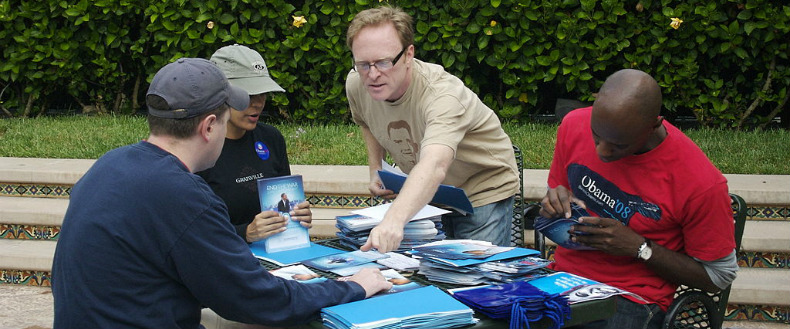Obama 2008 Field Team Photo via Wikipedia/Flickr user Matt B.
Ashley Parker and Jonathan Weisman of the Times went door-to-door with campaign field teams in North Carolina a few days back, and their write-up provides as good a description of the changes data-targeting has brought to traditional grassroots organizing as I’ve seen in the public prints. For a good summary of the theme, let’s start with this quote from Victory Lab author Sasha Issenberg:
“The great irony of the modern ground game is it’s this meeting of incredibly modern analytics and data married to very old-fashioned delivery devices,” he said. “It’s people knocking on doors; it’s people making phone calls out of phone banks; but the calculations that are determining which door and which phone are different.”
Earlier in the article, the authors look at the kinds of data campaigns might use to target specific voters, including the always-mentioned magazine subscriptions:
So now, even before Emma Benson, a field director for the conservative political organization Americans for Prosperity, knocks on a door, she has more than 700 data points about the person behind it, like magazine subscriptions, car ownership (make, model, year), propensity for voting, and likes and dislikes mined from Facebook and Twitter, from rock bands to baseball teams. All fodder for her pitch for voters to throw out Senator Kay Hagan, a Democrat.
To be sure, I doubt very seriously that her canvassing phone app displayed all that data, but that instead it went into the data modeling that built the list of houses she should visit. Equally key is the uploading of NEW data acquired in doorstep and driveway conversations:
On a Monday night in Durham, Ekundayo Akinloye, a field manager for Working America, the community arm of the A.F.L.-C.I.O., walked in an upscale neighborhood. An iPhone app helped her choose which doors to knock, with a goal of 20 to 30 an hour, and as well as a dozen “IDs” — a voter’s key issue and which candidate he or she is likely to support.
When one voter cited her top concern as “women’s rights, women’s rights, women’s rights,” Ms. Akinloye immediately put the information into her phone, and it was sent to headquarters to refine targeting.
As we saw above, the article spends time with canvassers from Americans for Prosperity, whose foray into field organizing we covered a couple of weeks back. Does their work herald a new era of conservative grassroots organizing, or will it remain a shadow of the shoe-leather emphasis of Democratic groups? Regardless, we can expect the integration of data-driven targeting and person-to-person politics to continue. And if Democrats are really lucky, it’ll save their butts next week. Check out the Times piece if you want to see a vital side of modern politics.
– cpd

